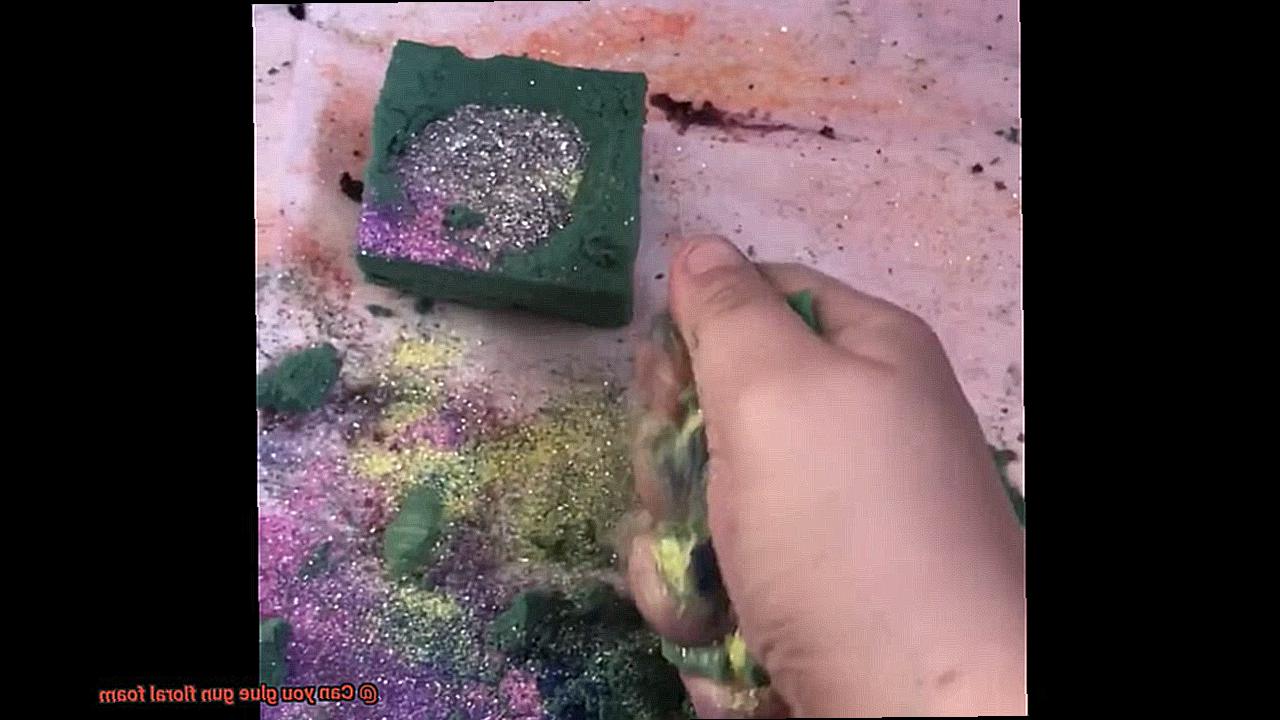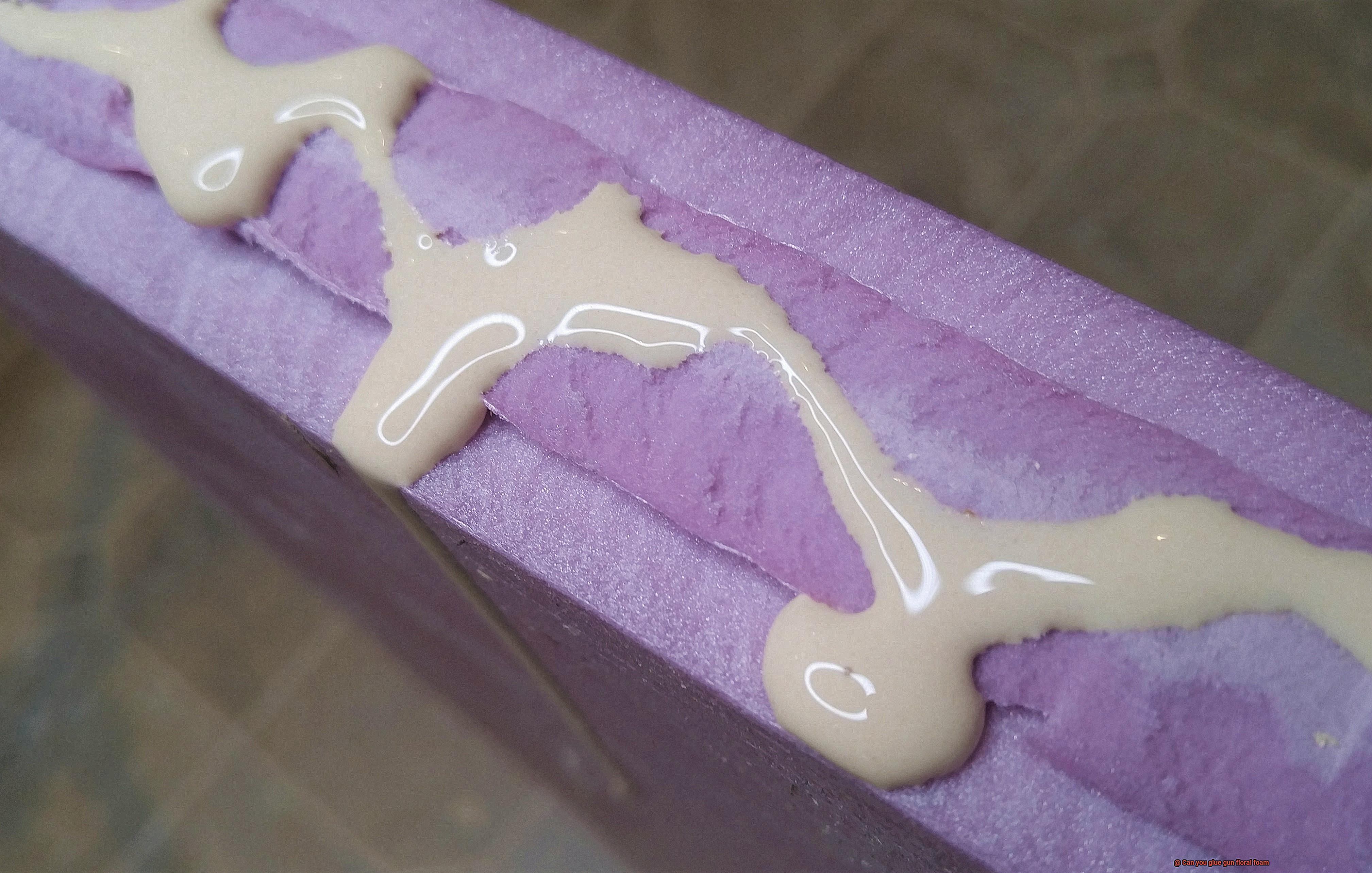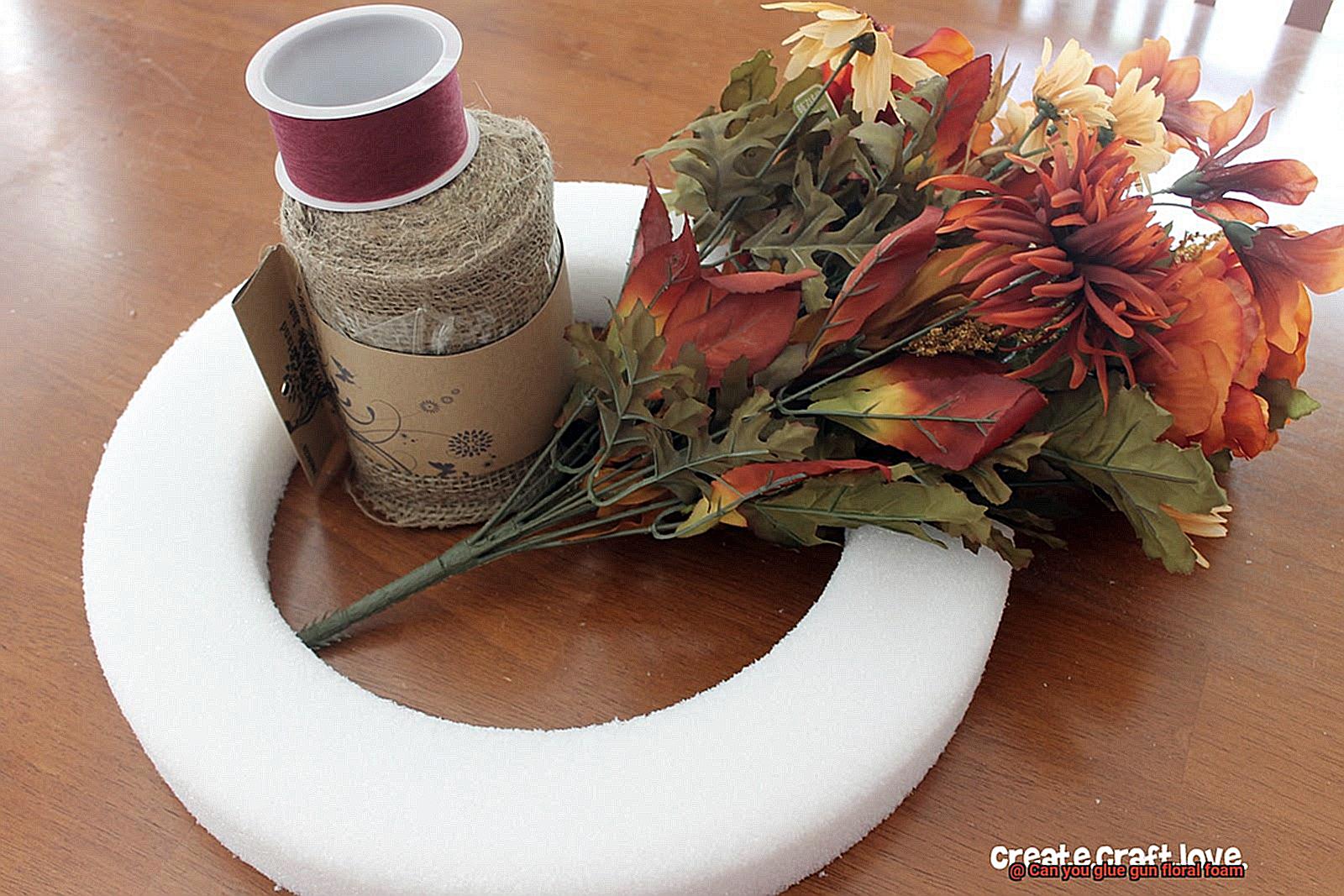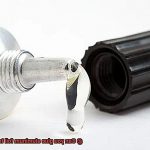Step into our crafters’ haven, where we’re about to unlock the true power of glue guns. Today, we’re diving deep into a burning question that often pops up when working with floral foam: can you use a trusty glue gun to securely attach and manipulate this delicate material?
Whether you’re a seasoned florist or just starting out on your DIY journey, the notion of using a glue gun on floral foam might seem like pure genius mixed with a dash of confusion. But fear not. We’re here to shed some light on this fascinating topic, sharing insights, tips, and tricks that will help you unleash the full potential of these adhesive wonders.
So buckle up as we embark on this creative adventure together. We’ll explore endless possibilities and uncover the secrets behind glue guns and their compatibility with floral foam. Get ready to find out if this unconventional union is truly a match made in crafting heaven.
What Is Floral Foam?
Contents
- 1 What Is Floral Foam?
- 2 Types of Glue Guns and Adhesives
- 2.1 Types of Glue Guns:
- 2.2 Types of Adhesives:
- 2.3 Pressure-Sensitive Adhesive Cartridges: Specialty glue guns designed for pressure-sensitive adhesive cartridges offer unique benefits for specific projects. These adhesives have properties such as increased flexibility or resistance to moisture. Applied similarly to hot melt adhesives, they provide excellent bonding options for particular requirements.
- 2.4 Choosing the Right Glue Gun and Adhesive:
- 3 Preparing the Floral Foam for Gluing
- 4 How to Glue Gun Floral Foam
- 5 Working Quickly with Hot Melt Adhesives
- 6 Heat-Resistant Pads and Surfaces
- 7 Applying the Right Amount of Glue
- 8 Aftercare Tips for Bonded Floral Foam
- 9 Conclusion
Floral foam, also known as oasis foam, is a remarkable material that plays a crucial role in the world of floral arrangements. This lightweight and porous substance serves as a support system for flowers and foliage, ensuring their longevity and vibrancy. But what exactly is floral foam and how does it work?
At its core, floral foam is made from phenolic foam, a synthetic material with exceptional water absorption capabilities. It can hold up to 40 times its weight in water, making it an ideal choice for providing hydration to flowers. The foam is typically green in color, blending seamlessly with the surrounding foliage and flowers in an arrangement.
Floral foam comes in various shapes and sizes, including blocks, spheres, and cylinders. This versatility allows florists and DIY enthusiasts to create unique designs by easily cutting and shaping the foam to fit their desired containers or floral forms.
One of the key benefits of using floral foam is its ability to extend the vase life of flowers. By absorbing water and keeping it readily available to the stems, the foam ensures that the flowers remain fresh and hydrated for extended periods of time. This not only enhances the visual appeal of the arrangement but also reduces the need for frequent water changes.
Moreover, floral foam acts as a stable base for the arrangement, preventing flowers from toppling over or shifting during transportation or display. This structural support allows for more elaborate designs and arrangements without compromising stability.

While floral foam is widely used in the industry, it is important to note that it is not biodegradable and can have negative environmental impacts. As a result, efforts are being made to develop alternative materials such as biofoam or other sustainable options that can provide similar benefits without harming the environment.
Types of Glue Guns and Adhesives
If you enjoy creating stunning floral arrangements or working with floral foam in your crafts, understanding the different types of glue guns and adhesives available is crucial. These tools are essential for securely bonding materials together. In this article, we will explore the various types of glue guns and adhesives specifically designed for gluing floral foam, allowing you to create beautiful creations effortlessly.
Types of Glue Guns:
- Low-Temperature Glue Guns: For beginners or when working with delicate materials like floral foam, low-temperature glue guns are the ideal choice. Operating at lower temperatures, typically around 250 degrees Fahrenheit, these guns use low-melt adhesive sticks with a lower melting point, ensuring that the foam remains undamaged.
- High-Temperature Glue Guns: When working on heavy-duty projects or requiring a stronger bond, high-temperature glue guns are the go-to option. With temperatures reaching up to 400 degrees Fahrenheit, they can melt adhesive faster and create a more robust bond. However, caution must be exercised to avoid melting or damaging the floral foam.
Types of Adhesives:
- Hot Melt Adhesive Sticks: Hot melt adhesive sticks are the most common adhesives used with glue guns. Available in various sizes and formulations, such as clear or colored, they cater to different applications. Once melted and cooled, these sticks provide a strong bond.
- Hot Melt Adhesive Pellets: Some glue gun models allow the use of adhesive pellets. These pellets are placed in a melting pot within the glue gun and melted as needed. This method ensures continuous use without frequent reloading of adhesive sticks.
-
Pressure-Sensitive Adhesive Cartridges: Specialty glue guns designed for pressure-sensitive adhesive cartridges offer unique benefits for specific projects. These adhesives have properties such as increased flexibility or resistance to moisture. Applied similarly to hot melt adhesives, they provide excellent bonding options for particular requirements.
Choosing the Right Glue Gun and Adhesive:
When gluing floral foam, it is crucial to select a low-temperature glue gun to avoid melting or damaging the foam. Opt for hot melt adhesive sticks or pellets with a low melting point for the best results. Apply the adhesive evenly, working in sections, and allow it to cool before attaching items to the foam.
Preparing the Floral Foam for Gluing
Floral foam is not just a mere accessory in the world of floral arrangements; it is the unsung hero that holds our creations together. Whether you’re a seasoned florist or an enthusiastic DIY-er, mastering the art of preparing and gluing floral foam is key to creating breathtaking designs that stand the test of time. In this comprehensive guide, we’ll take you through the step-by-step process of preparing floral foam for gluing, ensuring your arrangements are nothing short of spectacular.
Selecting the Right Type of Floral Foam:
Before embarking on your gluing journey, it’s vital to choose the appropriate floral foam for your project. Different types of floral foam cater to different needs. Consider whether you’re working with fresh or artificial flowers, as there are specific foams designed for each purpose.
Soaking and Draining the Foam:
To unleash its full potential, soak the floral foam in water until it achieves a state of complete saturation. This ensures optimal hydration for fresh flowers and creates a stable foundation for your arrangement. Once saturated, gently squeeze out any excess moisture without compromising its structure.
Shaping the Foam:
Like a sculptor shaping clay, trim the floral foam to fit snugly inside your container. Utilize a sharp knife or floral cutter to carve out the perfect size and shape, leaving no room for gaps or empty spaces.
Cleaning the Foam Surface:
Before diving into gluing action, take a moment to clean the surface of the foam using a damp cloth or sponge. This simple step removes any debris or dirt, guaranteeing better adhesion between the glue and the foam.
Gluing Techniques:
Prepare to unleash your creativity. For secure bonding, arm yourself with a hot glue gun and high-temperature glue sticks. Apply the hot glue directly onto the surface of the foam where you want to attach an item, such as ribbons, ornaments, or additional flowers. Press firmly and hold for a few seconds until the glue sets. Repeat this process for each item, ensuring each attachment is secured with enough glue.
Drying and Setting:
Patience is key. Allow the glue to fully dry and set before handling or manipulating the arrangement. This crucial step ensures that your attachments remain firmly in place, preventing any unfortunate mishaps.
Consider Alternative Adhesives:
While hot glue is a go-to option, it may not be suitable for all materials. Delicate or heat-sensitive items call for specialized adhesives that cater to their unique needs. Be sure to explore alternative options based on the materials you are working with.
How to Glue Gun Floral Foam
Well, you’re in for a treat because today we will be discussing how to effectively use a glue gun to secure floral foam. This technique is beloved by florists and crafters alike as it enables easy attachment of flowers, foliage, and decorations, resulting in breathtaking designs. So, without further ado, let’s dive right in.
Gather Your Materials:
Before we begin, ensure that you have all the necessary materials at hand. You will need floral foam, a glue gun, glue sticks, and, of course, your exquisite flowers or decorations. Now that we are well-equipped, let us move on to the next step.

Select the Appropriate Foam:
There are various types of floral foam available, so it is crucial to choose the right one for your project. If you are working with fresh flowers, opt for wet foam that can retain water and keep your blooms fresh. For artificial flowers or decorations, dry foam is the way to go.
Prepare the Foam:

Now that you have selected your foam, it is time to properly prepare it. If you are using wet foam, saturate it in water until completely soaked. Dry foam does not require soaking but misting it with water will enhance its ability to hold fresh flowers.
Heat Up Your Glue Gun:
Plug in your glue gun and allow it to heat up. For optimal adhesion, we recommend using a high-temperature glue gun. Once heated and ready for action, insert a glue stick into the back of the gun and push it until securely fitted.
Apply the Glue:
Gently squeeze the trigger of the glue gun to dispense a small amount of hot glue onto the floral foam. Exercise caution to avoid applying excessive pressure as it may melt or damage the foam. Swiftly attach your decoration or flower onto the hot glue before it cools down, firmly pressing it into place for a secure bond.
Keep Going:
Continue the gluing process, attaching additional decorations or flowers in the same manner. Work systematically to cover the entire surface of the floral foam. Unleash your creativity and let it flourish as you craft a masterpiece.
Working Quickly with Hot Melt Adhesives
Crafting beautiful floral arrangements requires working quickly and efficiently with hot melt adhesives, also known as glue sticks. These adhesive wonders provide a fast-setting nature and strong bond strength, making them the go-to choice for bonding floral foam. To ensure optimal results, follow these tips for working quickly with hot melt adhesives when gluing floral foam.
- Set the Right Temperature: Different types of floral foams have varying melting points, so choose a glue gun with a temperature setting that matches your specific foam. Start with a low-temperature setting and adjust as necessary to avoid damaging or melting the foam.
- Prepare the Surface: Before applying the adhesive, prepare the floral foam surface for better adhesion. Lightly sand or clean the area where the adhesive will be applied to create a clean and roughened surface, ensuring a stronger bond.
- Apply in Small Sections: Hot melt adhesives set rapidly once applied, so work quickly and apply the adhesive in small sections. This approach provides better control and prevents the adhesive from cooling down before securing the foam.
- Handle with Care: Glue guns can get extremely hot, so handle them with caution. Keep a safe distance from your fingers or any other body part while using the glue gun. Consider using a protective covering or mat on your working surface to prevent damage from hot glue drips or spills.
- Secure and Hold: After applying the adhesive to the floral foam, promptly press it onto the desired surface or object. Apply gentle pressure to ensure an even spread and a secure bond. Hold the foam firmly in place for a few seconds to allow the adhesive to cool and set properly.
Heat-Resistant Pads and Surfaces
Today, we’re delving into the world of glue gunning and exploring the critical role that heat-resistant pads and surfaces play in preserving the beauty of your floral creations. So grab a cup of tea, settle in, and let’s discover why these protective tools are a must-have for every glue gunner.
Shielding the Work Area:
Imagine this: you’re in the zone, delicately arranging beautiful blooms onto your floral foam masterpiece when suddenly disaster strikes. The scorching hot glue from your trusty glue gun seeps into the foam, causing it to melt and lose its shape. The horror. Fear not, for a heat-resistant pad or surface acts as a superhero cape, protecting your work area from direct contact with the intense heat generated by the glue gun. No more melted foam mishaps.
Ensuring Even Heat Distribution:
Just as a chef desires even cooking, you want your floral foam to receive equal treatment. A heat-resistant pad or surface ensures that the heat from the glue gun is distributed evenly, preventing any localized overheating that could damage the foam. This uniform distribution guarantees a stable and secure base for your flowers to shine in all their glory.

Safety First:
We’ve all experienced those moments when our hands have slipped or a tool has gone rogue. With a heat-resistant pad or surface beneath your floral foam, you gain an added layer of protection against accidents and spills. The stability and non-slip properties of these pads provide a secure platform to work on, reducing the risk of injury or damage to your materials.
Applying the Right Amount of Glue
Ah, the art of glue gunning. It’s a delicate dance of precision and creativity, where every dot and line of adhesive can make or break your masterpiece. When it comes to floral foam, finding that perfect balance of glue can be a challenge. You want a secure bond that holds your embellishments in place, but you also don’t want to drown your foam in a sea of adhesive.
So, how do you apply just the right amount of glue? Let’s dive in and explore some tips and tricks.
Firstly, before you start gluing, assess the weight of the elements you are attaching to the foam. Lightweight embellishments like small flowers or feathers typically require only a small dot or thin line of glue. It’s all about finding that sweet spot where just enough adhesive is used to hold everything securely.
When it comes to actually applying the glue, it’s best to apply it directly onto the foam instead of putting it on the embellishment itself. This allows for better control and distribution of the adhesive, ensuring that it is evenly spread across the surface and provides maximum bonding strength.
To determine if you’ve applied the right amount of glue, perform a test. Apply a small amount of glue and press the embellishment against the foam. If it holds securely without excess glue oozing out, then you’re on the right track. However, if you find that excess glue is seeping out around the edges of the embellishment, you’ve applied too much. No worries. Simply wipe away the excess with a clean cloth or paper towel before it dries.
It’s important to consider moisture absorption when working with floral foam. Floral foam is porous and easily absorbs moisture. Applying too much glue can prevent water from penetrating into the foam, which can negatively impact fresh flowers or plants in your arrangement. Keep this in mind as you gauge how much glue to use, and ensure that there is still enough space for water to flow and nourish your botanical beauties.
Lastly, patience is key. Always allow the glue to dry completely before handling or moving your floral arrangement. This ensures that the bond has fully set and provides maximum stability. Rushing the drying process can result in a weaker bond and potential damage to your hard work.
Aftercare Tips for Bonded Floral Foam
Now, let’s discuss the importance of proper aftercare to keep your foam masterpiece fresh and beautiful for as long as possible. These aftercare tips will help your floral creations bloom with vibrant colors and fabulous fragrances.
Store Properly: Treat Your Foam with TLC
After completing your masterpiece, it’s time to find a cozy home for your bonded floral foam. Remember, this delicate foam dislikes excessive heat or moisture. Give it the VIP treatment by storing it in a cool, dry place. To protect it from external factors, place it in an airtight container or plastic bag. This way, your foam will remain in tip-top shape for future floral adventures.
Cleanse Gently: Bye-Bye Excess Glue
Occasionally, a little bit of glue may escape during the crafting process. No worries. Easily remove it by gently brushing it off with a small brush or toothpick. Avoid using harsh chemicals or solvents as they might damage the foam. If necessary, use a mild soap solution to cleanse the foam, rinse thoroughly, and let it dry completely before storing or reusing.
Handle with Care: Fragile Foam Alert.
Bonded floral foam is as delicate as a butterfly’s wings. To prevent crumbles or breaks, handle it with utmost care when transporting or storing. Avoid sudden impacts or pressure on the foam, allowing it to maintain its shape and integrity.
Keep It Shady: The Sun Is Not Your Foam’s Friend
Just like humans need sunscreen to protect their skin, floral foam needs shade to stay healthy. Direct sunlight can be harsh on the foam, causing quick deterioration. So, keep your foam away from windows or any other sources of direct sunlight. Instead, find a cool and shady spot where it can chill out and relax.

Replace When Necessary: Out with the Old, In with the Fresh
Similar to a wilting flower, floral foam can lose its effectiveness or become damaged over time. That’s when you know it’s time to say goodbye and welcome a fresh block of floral foam. Keep an eye out for signs of mold, discoloration, or crumbling. When you spot these, don’t hesitate to replace the foam for a vibrant new start.
LZxydhzz_bI” >
Conclusion
In conclusion, the answer to the question “Can you glue gun floral foam?”
is a resounding yes. Glue gunning floral foam is not only possible, but it is also a convenient and effective way to secure your floral arrangements.
By using a hot glue gun, you can easily attach flowers, foliage, and other decorative elements to the foam without any hassle. This method provides a strong bond that keeps your arrangement intact and prevents any accidental dislodging.
Whether you’re creating a stunning centerpiece for a special event or crafting a beautiful wreath for your front door, using a glue gun on floral foam will give you the confidence and peace of mind that your creation will stay in place.






